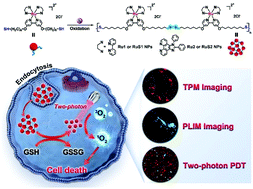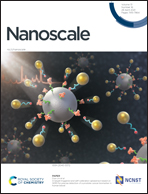Nano-assembly of ruthenium(ii) photosensitizers for endogenous glutathione depletion and enhanced two-photon photodynamic therapy†
Abstract
Photodynamic therapy (PDT) is a promising noninvasive cancer treatment. PDT in the clinic faces several hurdles due to the unique tumor environment, a feature of which is high levels of glutathione (GSH). An excess amount of GSH consumes reactive oxygen species (ROS) generated by photosensitizers (PSs), reducing PDT efficiency. Herein, nano-photosensitizers (RuS1 NPs and RuS2 NPs) are reported. These consist of ruthenium complexes joined by disulfide bonds forming GSH sensitive polymer nanoparticles. The NPs achieve enhanced uptake compared to their constituent monomers. Inside cancer cells, high levels of GSH break the S-S bonds releasing PS molecules in the cell. The level of GSH is also then reduced leading to excellent PDT activity. Furthermore, RuS2 NPs functionalized with tumor targeting hyaluronic acid (HA@RuS2 NPs) assessed in vivo were highly effective with minimal side effects. To the best of our knowledge, RuS NPs are the first metal complex-based nano-assembled photosensitizers which exhibit enhanced specificity and consume endogenous GSH simultaneously, thus achieving excellent two-photon PDT efficiency in vitro and in vivo.

- This article is part of the themed collection: 2021 Nanoscale HOT Article Collection


 Please wait while we load your content...
Please wait while we load your content...